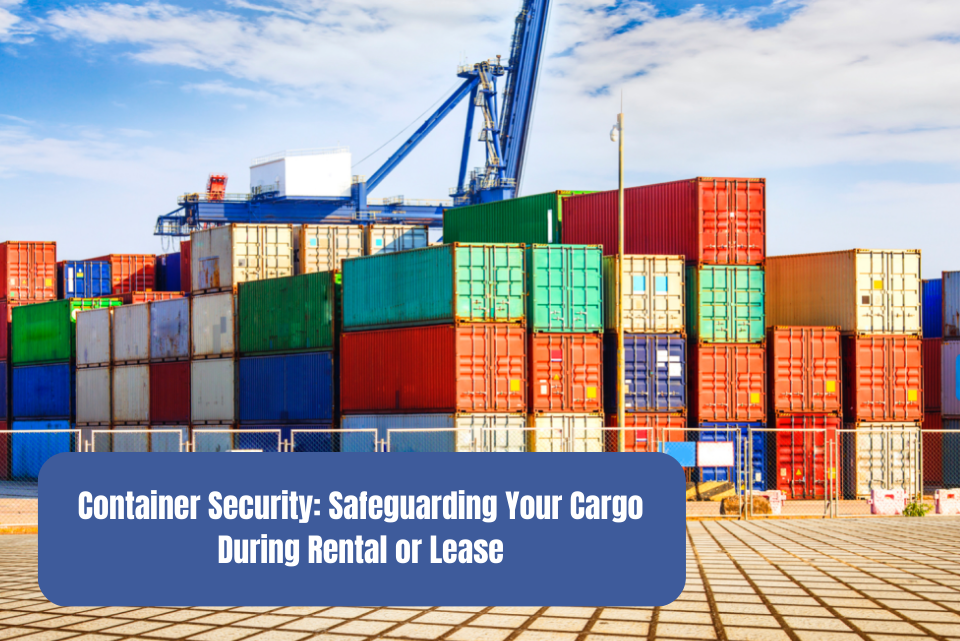Introduction
The global shipping industry relies heavily on containers to transport goods efficiently and securely. Whether you’re renting or leasing containers for your cargo, ensuring their security is paramount. In this article, we will delve into the world of container security and provide valuable insights into safeguarding your precious cargo during rental or lease arrangements.
Container Security Essentials
- Inspection and Maintenance: Before accepting a container for rental or lease, thoroughly inspect it. Look for any signs of damage, such as dents, rust, or leaks. Ensure that the container is clean and free from previous cargo residues. Regular maintenance and inspections during the lease period are crucial to identify and address potential issues promptly.
- Locking Systems: Invest in high-quality locking systems to deter unauthorized access. Padlocks, container seals, and electronic locks are common options. Choose a lock that aligns with your cargo’s value and security requirements. Ensure that lock mechanisms are regularly inspected and serviced.
- Surveillance and Tracking: Implement tracking and surveillance systems to monitor the container’s location and condition. GPS trackers and security cameras can provide real-time information about your container’s whereabouts and any suspicious activities.Many shipping companies offer tracking services as part of their container leasing packages.
- Sealing: Use tamper-evident seals to secure the container doors. These seals will show visible signs of tampering, deterring theft and unauthorized entry. Keep a record of seal numbers and inspect them upon container receipt and return.
- Documentation: Maintain detailed records of your container rental or lease agreement. Include information about container condition at the outset, any modifications made during the lease period, and records of inspections and maintenance. Accurate documentation is essential in case of disputes or insurance claims.
- Insurance: Consider cargo insurance that covers the container and its contents during transit. While insurance won’t prevent theft or damage, it provides financial protection in case of unforeseen events.
Challenges in Container Security
- Theft and Vandalism: Cargo theft is a significant concern in the shipping industry. Containers, especially those left unattended in transit or storage yards, can be vulnerable to theft and vandalism. Robust security measures are necessary to mitigate these risks.
- Unauthorized Use: Containers may be misused or repurposed without the lessor’s knowledge. This can lead to damage or loss of assets. Routine checks and inspections can help prevent such situations.
- Damage During Transport: Containers are subjected to rough handling and environmental conditions during transportation. Ensuring proper securing and packaging of cargo within the container is essential to prevent damage during transit.
- Regulatory Compliance: Different countries and regions may have specific regulations and security standards for container shipments. Compliance with these standards is crucial to avoid delays and penalties.
- Cybersecurity: As container tracking and management systems become more interconnected, the risk of cyberattacks on container management platforms increases. Protecting sensitive data and communication channels is essential for container security.
Best Practices for Container Security
- Risk Assessment: Conduct a thorough risk assessment to identify potential vulnerabilities in your container security strategy. This assessment should consider factors like the cargo’s value, transportation routes, and the security features of the container itself.
- Training and Awareness: Ensure that personnel involved in container handling are trained in security procedures. This includes recognizing signs of tampering, using locking systems effectively, and reporting suspicious activities promptly.
- Collaboration: Collaborate with shipping companies and logistics providers that prioritize container security. Verify their security protocols and tracking capabilities before selecting a service provider.
- Technology Integration: Embrace technology solutions for container security. Advanced tracking systems, access controls, and IoT-enabled devices can enhance security measures significantly.
- Regular Audits and Inspections: Implement a schedule for routine audits and inspections of containers. This includes both physical inspections and checks of security systems and documentation.
Conclusion
Container security is a critical aspect of the shipping and logistics industry. Whether you are renting or leasing containers for your cargo, taking proactive steps to secure your assets is essential. By investing in quality locking systems, implementing surveillance and tracking, maintaining accurate documentation, and addressing potential risks, you can protect your cargo from theft, damage, and unauthorized access.
Remember that container security is an ongoing process that requires vigilance and adaptability. Stay informed about emerging security threats and technology solutions to keep your cargo safe and ensure smooth, secure transit throughout the supply chain.



